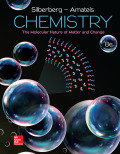
Concept explainers
(a)
Interpretation:
The
Concept introduction:
Crystal structure or lattice is the three-dimensional representation of atoms and molecules arranged in a particular manner. The unit cell is the smallest part of the lattice that is repeated in all directions to yield the crystal lattice. There are 3 types of cubic unit cells as follows:
1. The simple cubic unit cell
2. Body-centered unit cell
3. Face-centered unit cell
In the cubic unit cell, atom at the corner is shared by 8 adjacent cells so the contribution of an atom at the corner is
(a)
Answer to Problem 12.99P
The number of atoms in each unit cell is 4.
Explanation of Solution
Atom adopts face-centered cubic unit arrangement.
Face-centered cubic unit cell, 8 atoms are present at the corners of the cell and 6 atoms at the face of the cell. The contribution of an atom present at the corner is
The number of atoms in each unit cell is 4.
(b)
The volume of a unit cell is to be calculated.
Concept introduction:
Crystal structure or lattice is the three-dimensional representation of atoms and molecules arranged in a particular manner. The unit cell is the smallest part of the lattice that is repeated in all directions to yield the crystal lattice. There are 3 types of cubic unit cells as follows:
1. The simple cubic unit cell
2. Body-centered unit cell
3. Face-centered unit cell
In the cubic unit cell, atom at the corner is shared by 8 adjacent cells so the contribution of an atom at the corner is
(b)
Answer to Problem 12.99P
The volume of a unit cell is
Explanation of Solution
The formula to calculate the volume of the unit cell is as follows:
Substitute
The volume of a unit cell is
(c)
The mass of a unit cell is to be calculated.
Concept introduction:
Crystal structure or lattice is the three-dimensional representation of atoms and molecules arranged in a particular manner. The unit cell is the smallest part of the lattice that is repeated in all directions to yield the crystal lattice. There are 3 types of cubic unit cells as follows:
1. The simple cubic unit cell
2. Body-centered unit cell
3. Face-centered unit cell
In the cubic unit cell, atom at the corner is shared by 8 adjacent cells so the contribution of an atom at the corner is
(c)
Answer to Problem 12.99P
The mass of a unit cell is
Explanation of Solution
The formula to calculate the mass of the unit cell is as follows:
Substitute
The mass of a unit cell is
(d)
The approximate
Concept introduction:
Crystal structure or lattice is the three-dimensional representation of atoms and molecules arranged in a particular manner. The unit cell is the smallest part of the lattice that is repeated in all directions to yield the crystal lattice. There are 3 types of cubic unit cells as follows:
1. The simple cubic unit cell
2. Body-centered unit cell
3. Face-centered unit cell
In the cubic unit cell, atom at the corner is shared by 8 adjacent cells so the contribution of an atom at the corner is
The conversion factor to convert
(d)
Answer to Problem 12.99P
The approximate atomic mass for the element is
Explanation of Solution
One unit cell consists of 4 atoms.
The formula to calculate the mass of an atom is as follows:
Substitute
The approximate atomic mass for the element is
Want to see more full solutions like this?
Chapter 12 Solutions
EBK CHEMISTRY: THE MOLECULAR NATURE OF
 ChemistryChemistryISBN:9781305957404Author:Steven S. Zumdahl, Susan A. Zumdahl, Donald J. DeCostePublisher:Cengage Learning
ChemistryChemistryISBN:9781305957404Author:Steven S. Zumdahl, Susan A. Zumdahl, Donald J. DeCostePublisher:Cengage Learning ChemistryChemistryISBN:9781259911156Author:Raymond Chang Dr., Jason Overby ProfessorPublisher:McGraw-Hill Education
ChemistryChemistryISBN:9781259911156Author:Raymond Chang Dr., Jason Overby ProfessorPublisher:McGraw-Hill Education Principles of Instrumental AnalysisChemistryISBN:9781305577213Author:Douglas A. Skoog, F. James Holler, Stanley R. CrouchPublisher:Cengage Learning
Principles of Instrumental AnalysisChemistryISBN:9781305577213Author:Douglas A. Skoog, F. James Holler, Stanley R. CrouchPublisher:Cengage Learning Organic ChemistryChemistryISBN:9780078021558Author:Janice Gorzynski Smith Dr.Publisher:McGraw-Hill Education
Organic ChemistryChemistryISBN:9780078021558Author:Janice Gorzynski Smith Dr.Publisher:McGraw-Hill Education Chemistry: Principles and ReactionsChemistryISBN:9781305079373Author:William L. Masterton, Cecile N. HurleyPublisher:Cengage Learning
Chemistry: Principles and ReactionsChemistryISBN:9781305079373Author:William L. Masterton, Cecile N. HurleyPublisher:Cengage Learning Elementary Principles of Chemical Processes, Bind...ChemistryISBN:9781118431221Author:Richard M. Felder, Ronald W. Rousseau, Lisa G. BullardPublisher:WILEY
Elementary Principles of Chemical Processes, Bind...ChemistryISBN:9781118431221Author:Richard M. Felder, Ronald W. Rousseau, Lisa G. BullardPublisher:WILEY





